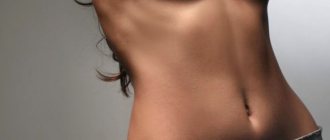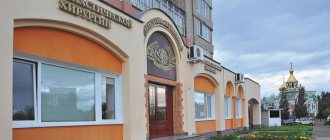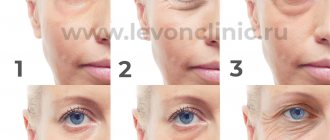Abdominoplasty is a major surgical procedure aimed at creating an aesthetically pleasing appearance of the front part of the abdomen by eliminating fat, skin folds and stretch marks, restoring loose abdominal muscles and restoring the normal position of the navel.
Types of abdominoplasty
- A mini abdominoplasty is a limited tuck that only affects the lower abdomen and does not correct the position of the navel. It features a small incision and rapid healing of the intervention area.
- classic abdominoplasty without navel transfer is a simultaneous correction of the upper and lower abdomen, in which the removal of excess subcutaneous fat and stretched skin does not create the need to move the navel.
- classic abdominoplasty with navel transfer is an extensive operation to correct the upper and lower parts of the abdomen, involving tightening the muscles of the abdominal wall, removing subcutaneous fat and excess stretched skin. Due to the tension and “sliding” of the skin flap down, the navel is transferred to a new bed.
- abdominoplasty with suturing of diastasis - involves an incision in the lower abdomen, narrowing its “white line” and eliminating excess skin and fat. If necessary, a new position of the navel is formed.
- vertical abdominoplasty - involves a small vertical incision through which excess tissue is removed. In this case, the skin moves from the sides to the middle of the abdomen.
- navel plastic surgery (umbilicoplasty) is a correction that allows you to eliminate defects formed after abdominoplasty without moving the navel. The operation is also indicated after liposuction of the abdomen with subsequent skin tension or if it is necessary to eliminate the consequences of mechanical injuries.
Operation
“Abdominoplasty is not an abdominal operation; we do not penetrate into the abdominal cavity; the intervention is performed at the level of subcutaneous fat without dissecting muscle tissue. But the operation is complex and potentially fraught with serious complications. And although abdominoplasty began to be performed a very long time ago, only recently has a method been developed that reduces postoperative complications to a minimum,” says Gulyaev.
During abdominoplasty, doctors remove a large flap of skin and pull it down. It looks like the skin on a drum has been re-stretched: it has been separated, stretched, and the excess has been cut off - roughly, but visibly. Such a surgical procedure is a great trauma for the body.
Previously, during the operation, a very large flap was separated up to the costal arch. Inevitably, when excising fat, blood vessels were crossed. Because of this, in the postoperative period the blood supply to the prepared flap was disrupted and there was a high probability of developing tissue necrosis. In addition, when separating the flap to the costal arch, Thompson's fascia (a deep layer of the superficial fascia of the abdomen), rich in lymphatic vessels, which contribute to the rapid resorption of tissue fluid after surgery, was damaged. This, in turn, led to excessive swelling and the development of complications such as seroma (accumulation of serous fluid), which required long-term drainage with special tubes.
Indications for abdominoplasty
- ptosis of the anterior abdominal wall;
- skin/fat apron;
- pronounced folds;
- stretch marks, stretch marks;
- separation and stretching of the abdominal muscles;
- rough and unaesthetic postoperative sutures;
- excess adipose tissue under the anterior abdominal wall;
- loss of skin elasticity;
- abdominal wall hernia.
Abdominoplasty
Abdominoplasty or tummy tuck is an operation to correct the shape of the abdomen and restore aesthetically correct proportions of the body.
The operation looks like this: excess fat is removed from the abdominal cavity. The connective tissue in the abdominal cavity (fascia) is tightened with sutures. The remaining skin is repositioned to create a tighter appearance.
Who should have a tummy tuck and why?
A tummy tuck is suitable for men and women in good health. Women who have had multiple pregnancies.
- Removal of loose skin, especially after liposuction
- Removal of fat and loose skin around the abdomen when diet and exercise no longer help
- Reducing stretch marks
- Restoration of the rectus abdominis muscles with severe divergence
- Elimination of hernia of the white line of the abdomen
- Silhouette improvement
- Removal of skin-fat “apron”
- Correction of scars after operations
We recommend a comprehensive procedure that includes diastasis stitching and a tummy tuck.
How is tummy tuck surgery performed?
- Together with the surgeon, you determine the areas of correction - this could be the front of the abdomen or removal of skin in a circle.
- The operation is performed under general anesthesia. To eliminate the risk of infection during surgery, your doctor may administer an antibiotic.
- The plastic surgeon makes incisions and removes skin and fat between the navel and pubic area.
- The connective tissue (fascia) located over the abdominal muscles is tightened and sutured.
- After the operation, the suture is closed with a surgical bandage.
- You will be escorted to the rest room.
Abdominoplasty lasts 2-3 hours depending on the complexity of the operation.
Are there complications after abdominoplasty?
Can be. However, a tummy tuck is not a new operation, all complications are already known and the risks are minimized.
Are there any contraindications to tummy tuck?
Yes. Doctors do not recommend doing abdominoplasty if you are planning a pregnancy or, conversely, seriously losing weight. Diabetes mellitus and chronic heart disease are also on the list of contraindications for surgery.
Abdominoplasty results: before and after photos
Removing excess skin and fat and strengthening the abdominal wall will make your stomach firmer and slimmer. The results of a tummy tuck are long lasting as long as your weight is stable.
You can see all the results of the work of surgeons at the New World Surgery clinic below.
How to prepare for tummy tuck?
- Sign up for a consultation
. You will talk about your goals and find out from your plastic surgeon whether it will be a full abdominoplasty, a partial abdominoplasty, or a mini abdominoplasty.
- Stop smoking at least 2 weeks before surgery and for another 2 weeks after surgery. Quitting smoking increases the speed of recovery.
- Work out a well-balanced menu with your doctor. A healthy diet will help you get better faster.
- You may need to stop taking any medications you are taking. Your surgeon will tell you which medications will need to be eliminated and for how long.
- Maintaining a stable weight for 12 months before tummy tuck surgery is ideal. If you are overweight, your doctor will most likely recommend losing weight.
How much does abdominoplasty cost?
The price of tummy tuck varies from 200 thousand to 496 thousand rubles, depending on what exactly the patient wants to correct. You can see the full price list for the clinic’s services below.
Everything you need to know about abdominoplasty
How many days will you spend in hospital?
2-3 days.
How is rehabilitation after abdominoplasty?
5-7 days
- severe pain in the diastasis area, the patient can walk slightly bending over.
1 month
- complete rehabilitation.
Follow-up diet and proper exercise after surgery are extremely important. Be sure to follow your doctor's recommendations.
Do I need to wear compression garments after the procedure?
Yes, to finally sculpt the figure.
1st month continuously.
2nd month - wear at night.
Wearing compression garments also helps prevent fluid buildup and provides support for the abdomen while it heals. Your doctor will explain how to care for your scar.
We order compression garments from Spain especially for you.
Do you need a vacation?
Yes. We recommend taking at least 1 week off. Painful sensations may persist for 3-5 days after tummy tuck. This is a serious operation. Rest will be required.
Abdominoplasty is performed by experienced surgeons at the New World Surgery clinic, and dozens of our clients are satisfied with the results of their work.
How is abdominoplasty performed?
Any type of abdominoplasty begins with marking the patient's abdomen in a standing position, determining the exact amount of excess skin and fat tissue to achieve a symmetrical result. After the administration of anesthesia and its full effect, the surgeon makes incisions. The direction and location of the incisions are determined by the specifics of the problem being solved and the chosen technique for eliminating it. So, with mini abdominoplasty, an incision is made in the pubic area along the hairline. If there are indications for a second incision, it is made perpendicular or vertical to the first. The length of the incisions varies depending on the indications and averages 5 cm. If significant skin tightening is necessary, an additional incision is made around the navel.
Next, the surgeon begins the main procedure, during which the fatty tissue and skin are carefully separated from the muscle walls. If indicated, the muscle walls are sutured. Next, the doctor sutures the connective tissue aponeurosis, modeling a flat abdomen. At the end of the procedure, the incisions are closed using special sutures, which are treated with an antiseptic and covered with a sterile bandage, and a drainage tube is installed. The patient is immediately put on special compression garments.
In a new way
Alexander Gulyaev: “Today abdominoplasty is performed together with liposuction. This gives more benefits. Fat can be removed without damaging blood vessels. After this, a skin flap is separated, already freed from fat and more mobile. It can be pulled down without damaging the blood vessels. Blood circulation is maintained, there is no risk of tissue necrosis. The use of liposuction made it possible to avoid large preparations up to the costal arch. A smaller flap is separated, and we do not affect Thompson's fascia, which means rapid absorption of tissue fluid occurs. When performing this operation, we install drainages only for prophylaxis, for 1-2 days. Of course, there is swelling, but long-term drainage is not required. In addition, when eliminating muscle diastasis, we do not dissect the internal muscle tissue, we do not cut anything off; in other words, we suturing, sewing together the separated muscles so that there is not even an unnecessary cavity left between them. Thus, abdominoplasty performed together with liposuction reduces the risk of complications to a minimum. Not to mention that by removing fat from the sides and lumbar region, we can shape the waist.”
After abdominoplasty, patients are discharged home on the 3-4th day. You must wear compression garments for a month. There are no further restrictions. The operation is not a contraindication for future pregnancy.
Rehabilitation period after abdominoplasty
Depending on the extent of the surgical intervention the patient has undergone, complete rehabilitation can take from 2 to 6 months. During the period of primary rehabilitation, it is strictly forbidden to violate the surgeon’s recommendations:
- full bathing is allowed only after a week;
- the first two weeks it is recommended to walk, lie and sit in a slightly bent position, sexual rest is indicated;
- after removing the stitches, you must wear compression garments for 2 months;
- Until the body is completely restored (3-6 months), physical activity is prohibited.
In the first few days, strict bed rest is indicated. Sitting is allowed on days 3-5, during which time the drainage tube is removed. After a few weeks, the stitches are removed.
After tummy tuck
Once you have decided to have an abdominoplasty, you will need to wear a certain type of compression garment as prescribed by your doctor for a period of time. It helps:
- reduce swelling;
- create a feeling of comfort and proper support;
- reduce fluid accumulation.
The surgeon may also recommend wearing a brace. It is important to follow these tips to speed up the recovery process.
Some patients may need to be hospitalized for a week (standard plastic surgery), while others may be discharged within a day, for example, after endoscopic abdominal correction.
After abdominoplasty, there may be some pain at the incision sites, swelling, and bruising, but they disappear within a few weeks. The main thing is not to overload the body, but you can go for short walks, as walking improves blood circulation.
Most patients who decide to undergo tummy tuck return to work, normal physical activity and daily activities within 1-3 weeks. In some cases, it takes about 4 weeks to fully return to normal activities, including playing sports and lifting heavy objects. Over time, the seams become almost invisible.
It is important to consider that after pregnancy or sudden weight fluctuations, the results of abdominoplasty may decrease. But if you watch your figure and do not intend to give birth due to age or other reasons, the good results of surgical tummy tuck will last for many years.
If you want to get a beautiful figure and get rid of pathologies, the doctors of our clinic in Novorossiysk will be glad to see you as their client. We care about our patients and do everything possible to ensure that you are satisfied with our services.
Author of the article
Plastic surgeon
Astashkin Pavel Vyacheslavovich
Contraindications to abdominoplasty
- planning pregnancy in the first year after surgery;
- diabetes;
- serious dysfunction of the thyroid gland;
- oncology;
- mental disorders
- disruption of the functioning of the hematopoietic organs;
- rheumatism, renal failure;
- hepatitis, HIV, AIDS;
- hypertension, severe cardiovascular diseases;
- obesity 3 and 4 degrees;
- connective tissue diseases;
- varicose veins of the lower extremities;
- psoriasis, fungal infections and purulent skin pathologies in the intervention area.








